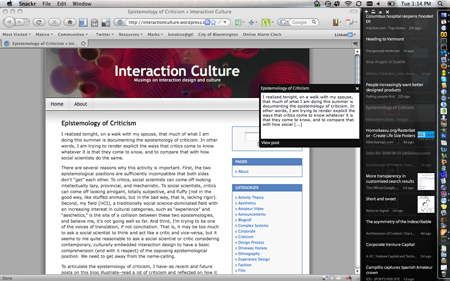I am in love. I’ve only been seeing this desktop application for a couple days. It isn’t perfect, but the potential is there for a lifelong relationship. Hello, Snackr.
Snackr is an RSS ticker that pulls news items from the feeds you give it and scrolls them across your screen. The default orientation is situated at the bottom of the display, but Snackr has the option to place the info at any edge. As you see titles of note, you click to pop up the news item description or click again to have it open up in a new web browser window.
The app has been out for a while, but I only tried it this week after reading a blog post about pairing Web 2.0 tools. For me, it was a habit-changing experience from the first launch. Although there aren’t yet enough controls over the display, the desktop application does allow you to control the placement of the scroll, its speed, its persistence, and the maximum age of the information flowing past you.
Reuniting my routine with RSS
On my MacBook—where vertical real estate is at a premium—I opted to run it bottom to top along the right side of my screen. When I need a window to peer down to my desktop for files and folders, it is an easy matter to collapse the scroller to hide it. When applicable, the moving title panes include a thumbnail of a logo or photo accompanying the feed. After selecting a title to view, the words gray out to make it easy to see what you have and have not examined.
Snackr accepts OPML files, which means exporting Google Reader feeds and importing them to Snackr is a simple and straightforward maneuver. At some point in the future, the two tools may be linked directly for constant synchronization.
Since Bloomington Startup Weekend at the start of the year, I have had a difficult time finding time and inclination to process my (too) many blog feeds. I continue to use Reader as a repository for all local blogs I encounter and those of IU School of Informatics students and faculty. However, both Twine and Twitter have replaced Reader as my main source of new information. Snackr brings RSS back into my life in a low-effort, ambient manner that I can choose to ignore or quickly scan during breaks.
To enhance its value, I created a new category for all of the most important feeds from my long list of blogs. Snackr now shows me only the past seven days of the content produced by those sources, allowing me to filter out a lot of the content I merely archive without reading. It will be wonderful when a version shows that allows my reading habits in Snackr to be tracked as part of Google Reader’s trends.
There is still room for improvement, of course. I think I would give up Twitterrific as my Twitter client if there Snackr could show me my new tweets as they came in. This is possible through my “with friends” RSS feed, but I would want the ability to shade the Twitter content differently to visually separate it from the blog and news titles. There also isn’t a way to reply or direct message, which is the main reason why Twitterrific remains my primary application. I would also like to be able to force the viewed web pages into new tabs, rather than opening up ever item into a new window.
Snackr runs on the Adobe AIR platform, which works well on Mac and Windows but not quite on Linux. The app has the obligatory blog and Twitter account, as well as an issue tracker for full transparency about bug fixes and feature additions.
